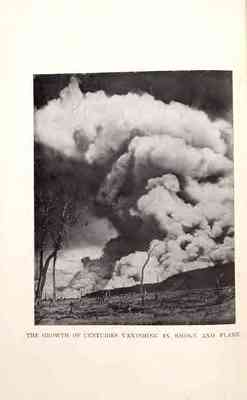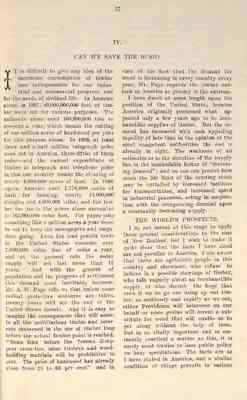Pages
This page is blank
[Illustration]
THE GROWTH OF CENTURIES VANISHING IN SMOKE AND FLAME.
IV.
CAN WE SAVE THE BUSH?
IT is difficult to give any idea of the enormous consumption of timber now indispensable for our industrial and commercial progress, and for the needs of civilised life. In America along, in 1907, 40,000,000,000 feet of timber were cut for various purposes. The railroads along need 100,000,000 tied or sleepers a year, which means the cutting of one million acres of hardwood per year for this purpose alon. In 1906, at least three and a-half million telegraph poles were cut in America, three-fifths of them cedar--and the annual expenditure of timber in telegraph and telephone poles in this one country means the clearing of nearly 4,000,000 acres of land. In 1906 again, America used 1,370,000 cords of bark for tanning, enarly 12,000,000 shingles and 4,000,000 laths; and the timber for use in the minds alone amounted to 165,000,000 cubic feet.For paper-pulp something like a million acres a year must be cut to keep the newspapers and magzines going. Even the lead pencils made in the United Stats consume over 7,000,000 cubic feet of cedar a year, and at the present rate the cedar supply will not last more than 12 years. And the growth of population and the progress of settlement this deman must inevitably increase. Mr. A. W. Page tells us that unless some radical protective measures are taken, twenty years will see the end of the United States forests. And it is easy to imagine the consequences that will ensue to all the multiarious trades and interests concerned in the use of timber long before the actual famine point is reached. "Some time befroe the forests disappear cross-ties, mine timbers and woodbuilding matrials will be prohibitive in cost. The price of hardwood has already rise from 25 to 65 per cent" and in view of the fact that the demand for wood is increasing in every country every year, Mr. Page regards the timer outlook in America as gloomy in the extreme.
I have dwelt at some length upon the position of the United States because America originally possessed what appeared only a few years ago to be inexhaustible supplies of timber. But the demand has increased with such appalling rapidity of late that in the opinion of the most competent authorities the end is already in sight The weakness of all estimates as to the duration of the supply lies in the incalculable factror of "increasing demand"; and no one can predict how much the life limit of the existing stock may be curtailed by increased facilities for transportation, and increased speed in indistrial processes, acting in conjunction with the evergrowing demand upon a constantly decreasing supply.
THE WORLD'S PROSPECTS.
I do not intend at this stage to apply these general considerations to the case of New Zealand, but I wish to make it quite clear that the facts I have cited are not peculiar to America. I am aware that there are optimistic people in this country and elsewhere, who refuse to believe in a possible shortage of timber, who talk vaguely about an inexhaustible supply, or who cherish the hope that even if we do go one using up our timber, as recklessly and rapdily as we can, etiher Providence will intervene on our behalf or some genius will invent a substitute for wood that will enable us to get along without the help of trees. But in so vitally important and seminently practical a matter as this, it is surely most unwise to base public policy on hazy speculations. The facts are as I have stated in America, and a similar condition of things previals in various
18
degrees throughout the civilized world. The able writer of the article on Frorestry in the last edition of the "Encyclopaedia Britannnica," after a brief survey of the world's failing stock of timber, points out that three countries, Russia, Scandinavia and Canada, have practically to supply the rest of the world with pine wood, and as the management of their forests is by no means satisfactory, "the question of the supply of light pine and fir which orm the very staff of life to the wood industries, must become a very serious matter before many years are passed. Unmistakable signs of the coming crisis are visible to all who wish to see, and it is difficut to overstate the gravity of the problem when it is remembered that 87 per cent. of all the timber imported into Great Britain is fir and light pine, and so for most of the other countries." This was written in 1901 and demand has certainly increased faster than the supply since then. Dealing with the same subject in 1903, Professor Schlich, probably the most eminent living authority on Forestry, points out that between 1894 and 1899 the average price of imported timber has risen about 18 per cent. and that there was every indication that it would rise further. So far as Great Britain's demand for timber is concerned, Professor Schlich held ten years ago that it was becoming more and more problematical then where the required material was to come from. "It is all very well to say that we can pay for the timber we need; but that will not meet the case. When the supplies from outside fall off the rise in price may] become prohibitive, and the effects of an insuffiency of material would be disastrous." The chief difficulty, as I have said, lies in the direction of the soft woods and Professor Schlich admits that "a deficiency of supply in the material would be a real calamity for the population of these islands." As to the possibility of substituting iron or steel, or any other material for timber, Professor Schlich holds that past experience gives very little hope of this solution of the problem. In spite of extraordinary efforts to find some means of replacing timber by iron and steel fro structural purposes, very little progress has been made either in England or France or the United States. As the President of the Institute of Civil Engineers said in 1903, the engineers cannot possibly do without a great deal of timber, and he pointed out that after thirty years' effort they had not yet succeeded in substituting steel for wood as sleepers and railway ties. When we consider that a genuine shortage of timber would not only stop railway building, but would preactically bring mining everywhere to a standstill, and would at the same time, throw millions of of emplyment in the building and other allied trades, we begin to realise that the threatened timber famine which unimpeachable evidence seems to show is rapidly approaching, may prove a terrible menace to the progress and prosperity of the world at large.
IS THERE A REMEDY?
Anyone who considers carefully such evidence as I have compiled must be driven to the conculsion that the risk of a timber famine is imminent and real, and that it is the positive duty of all civilized States to face this situation promptly and bodly. I may remind you at once that many European Governments have long since attempted to grappble with this problem in a practical way. But the proof of the inadequacy of their efforts in that, for example, France, with 18 per cent of her area under forest, Belgium with 17 per cent of her area under forest, and Germany with 26 per centt of her area under forest, are all compelled to import timber largely to satisfy their local needs. This fact is sufficient to show that countries like our own, which have so far done little or nothing to cope with the constant drain upon their own natural resources, can expect little aid from abroad when the crisis at least comes. The sole interest
This page is blank




